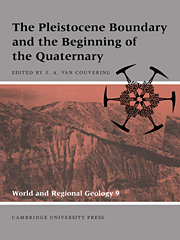Book contents
- Frontmatter
- Contents
- List of contributors
- Preface: the new Pleistocene
- Foreword
- Part I Definition of the base of the Quaternary
- Part II Characterization of the Pleistocene boundary-stratotype
- Part III The paleontological context of the Pleistocene boundary
- Part IV The Pleistocene boundary in regional sequences
- 11 The Pliocene–Pleistocene boundary in Italy
- 12 Stratigraphy of the Plio–Pleistocene sequence of the Mediterranean coastal belt of Israel and its implications for the evolution of the Nile Cone
- 13 The Pliocene–Pleistocene transition in the Iberian Peninsula
- 14 Biostratigraphy and calibrated climatic chronology of the Upper Pliocene and Lower Pleistocene of France
- 15 The Plio–Pleistocene of England and Iceland
- 16 The Neogene–Ouaternary boundary in The Netherlands
- 17 The Tertiary–Quaternary boundary in western Germany
- 18 The Pliocene–Pleistocene boundary in eastern Germany
- 19 The Plio–Pleistocene of Hungary
- 20 The Pliocene–Pleistocene boundary in Romania
- 21 The Pliocene and Pleistocene of the European part of the Commonwealth of Independent States
- 22 The N/Q boundary in Asian Russia and Tadjikistan
- 23 The Pliocene–Pleistocene boundary in the Indian subcontinent
- 24 The Pliocene–Pleistocene boundary in Japan: the Osaka Group, Kinki district
- 25 The Pliocene–Pleistocene boundary in Japan: stratigraphy in the Boso Peninsula, central Japan
- 26 The base of the Quaternary in China
- 27 Plio–Pleistocene deposits and the Quaternary boundary in sub-Saharan Africa
- 28 Plio–Pleistocene reference sections in Indonesia
- 29 The Pliocene–Pleistocene boundary in New Zealand
- 30 The Pliocene–Pleistocene boundary in continental sequences of North America
- Index
23 - The Pliocene–Pleistocene boundary in the Indian subcontinent
Published online by Cambridge University Press: 10 November 2009
- Frontmatter
- Contents
- List of contributors
- Preface: the new Pleistocene
- Foreword
- Part I Definition of the base of the Quaternary
- Part II Characterization of the Pleistocene boundary-stratotype
- Part III The paleontological context of the Pleistocene boundary
- Part IV The Pleistocene boundary in regional sequences
- 11 The Pliocene–Pleistocene boundary in Italy
- 12 Stratigraphy of the Plio–Pleistocene sequence of the Mediterranean coastal belt of Israel and its implications for the evolution of the Nile Cone
- 13 The Pliocene–Pleistocene transition in the Iberian Peninsula
- 14 Biostratigraphy and calibrated climatic chronology of the Upper Pliocene and Lower Pleistocene of France
- 15 The Plio–Pleistocene of England and Iceland
- 16 The Neogene–Ouaternary boundary in The Netherlands
- 17 The Tertiary–Quaternary boundary in western Germany
- 18 The Pliocene–Pleistocene boundary in eastern Germany
- 19 The Plio–Pleistocene of Hungary
- 20 The Pliocene–Pleistocene boundary in Romania
- 21 The Pliocene and Pleistocene of the European part of the Commonwealth of Independent States
- 22 The N/Q boundary in Asian Russia and Tadjikistan
- 23 The Pliocene–Pleistocene boundary in the Indian subcontinent
- 24 The Pliocene–Pleistocene boundary in Japan: the Osaka Group, Kinki district
- 25 The Pliocene–Pleistocene boundary in Japan: stratigraphy in the Boso Peninsula, central Japan
- 26 The base of the Quaternary in China
- 27 Plio–Pleistocene deposits and the Quaternary boundary in sub-Saharan Africa
- 28 Plio–Pleistocene reference sections in Indonesia
- 29 The Pliocene–Pleistocene boundary in New Zealand
- 30 The Pliocene–Pleistocene boundary in continental sequences of North America
- Index
Summary
Introduction
In 1973, the Geological Survey of India proposed a project on the Tertiary–Quaternary boundary to cover the global perspective of the boundary between the Pliocene and Pleistocene. This proposal was merged with the “Neogene/Quaternary Boundary” project initiated at about the same time by the Geological Institute of the USSR Academy of Sciences, thus giving rise to IGCP Project 41 (Nikiforova and Alekseev, Chapter 1, this volume).
The Indian national working group for IGCP-41 was formed in 1974 with M. V. A. Sastry as convenor and (from March 1981) with A. Ranga Rao as co-convenor. Members were as follows: B. S. Towari, Panjab University; V. V. Sastri, Oil and Natural Gas Commission, Dehra Dun; D. Niyogi, Indian Institute of Technology, Kharagpur; S. N. Rajaguru, Deccan College, Pune; M. S. Srinivasan, Banaras Hindu University; K. N. Prasad, K. K. Verma, and A. K. Dutta, Geological Survey of India. The working group functioned under the guidance of the director general of the Geological Survey of India, who was also the chairman of the Indian National Committee for the IGCP. A major contribution was the 1979 field conference on the Neogene–Quaternary boundary as it related to the Siwalik and the Karewa deposits of India, which stimulated much new work (Sastry et al., 1981). The present report contains the results of progress since that field conference.
Neogene and Quaternary deposits are widely exposed in the foothills of the Himalaya, in the Vale of Kashmir, in the coastal regions of the Indian peninsula, and in the Andaman Islands. While the Himalayan foothills, Kashmir, and peninsular India have continental deposits, the Andaman Islands preserve a good sequence of deep-water marine facies.
- Type
- Chapter
- Information
- The Pleistocene Boundary and the Beginning of the Quaternary , pp. 232 - 238Publisher: Cambridge University PressPrint publication year: 1996
- 1
- Cited by



